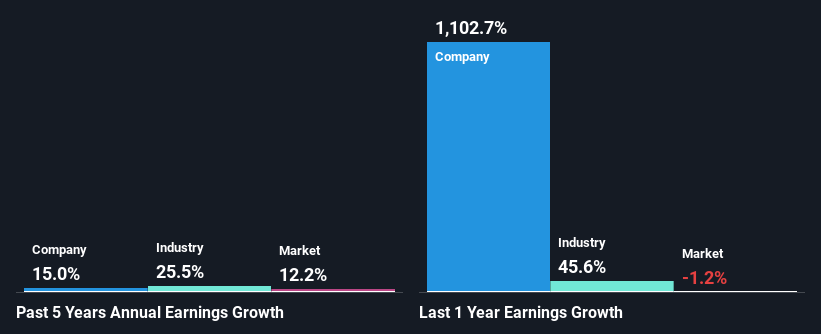- United Kingdom
- /
- Semiconductors
- /
- AIM:ENSI
EnSilica plc's (LON:ENSI) Stock Has Shown Weakness Lately But Financial Prospects Look Decent: Is The Market Wrong?
With its stock down 55% over the past three months, it is easy to disregard EnSilica (LON:ENSI). However, stock prices are usually driven by a company’s financials over the long term, which in this case look pretty respectable. In this article, we decided to focus on EnSilica's ROE.
Return on Equity or ROE is a test of how effectively a company is growing its value and managing investors’ money. Simply put, it is used to assess the profitability of a company in relation to its equity capital.
View our latest analysis for EnSilica
How Do You Calculate Return On Equity?
The formula for ROE is:
Return on Equity = Net Profit (from continuing operations) ÷ Shareholders' Equity
So, based on the above formula, the ROE for EnSilica is:
11% = UK£1.8m ÷ UK£16m (Based on the trailing twelve months to May 2023).
The 'return' is the yearly profit. Another way to think of that is that for every £1 worth of equity, the company was able to earn £0.11 in profit.
What Is The Relationship Between ROE And Earnings Growth?
We have already established that ROE serves as an efficient profit-generating gauge for a company's future earnings. Depending on how much of these profits the company reinvests or "retains", and how effectively it does so, we are then able to assess a company’s earnings growth potential. Generally speaking, other things being equal, firms with a high return on equity and profit retention, have a higher growth rate than firms that don’t share these attributes.
EnSilica's Earnings Growth And 11% ROE
To begin with, EnSilica seems to have a respectable ROE. Yet, the fact that the company's ROE is lower than the industry average of 18% does temper our expectations. Although, we can see that EnSilica saw a modest net income growth of 15% over the past five years. We reckon that there could be other factors at play here. For instance, the company has a low payout ratio or is being managed efficiently. Bear in mind, the company does have a respectable level of ROE. It is just that the industry ROE is higher. So this also does lend some color to the fairly high earnings growth seen by the company.
As a next step, we compared EnSilica's net income growth with the industry and were disappointed to see that the company's growth is lower than the industry average growth of 26% in the same period.

Earnings growth is a huge factor in stock valuation. The investor should try to establish if the expected growth or decline in earnings, whichever the case may be, is priced in. Doing so will help them establish if the stock's future looks promising or ominous. Is EnSilica fairly valued compared to other companies? These 3 valuation measures might help you decide.
Is EnSilica Making Efficient Use Of Its Profits?
Given that EnSilica doesn't pay any dividend to its shareholders, we infer that the company has been reinvesting all of its profits to grow its business.
Conclusion
In total, it does look like EnSilica has some positive aspects to its business. Particularly, its earnings have grown respectably as we saw earlier, which was likely achieved due to the company reinvesting most of its earnings at a decent rate of return, to grow its business. While we won't completely dismiss the company, what we would do, is try to ascertain how risky the business is to make a more informed decision around the company. You can see the 4 risks we have identified for EnSilica by visiting our risks dashboard for free on our platform here.
Valuation is complex, but we're here to simplify it.
Discover if EnSilica might be undervalued or overvalued with our detailed analysis, featuring fair value estimates, potential risks, dividends, insider trades, and its financial condition.
Access Free AnalysisHave feedback on this article? Concerned about the content? Get in touch with us directly. Alternatively, email editorial-team (at) simplywallst.com.
This article by Simply Wall St is general in nature. We provide commentary based on historical data and analyst forecasts only using an unbiased methodology and our articles are not intended to be financial advice. It does not constitute a recommendation to buy or sell any stock, and does not take account of your objectives, or your financial situation. We aim to bring you long-term focused analysis driven by fundamental data. Note that our analysis may not factor in the latest price-sensitive company announcements or qualitative material. Simply Wall St has no position in any stocks mentioned.
About AIM:ENSI
EnSilica
Designs and supplies designs and supplies complex mixed signal application specific integrated circuit chips in the United Kingdom, Rest of Europe, and internationally.
Adequate balance sheet with low risk.
Market Insights
Community Narratives



